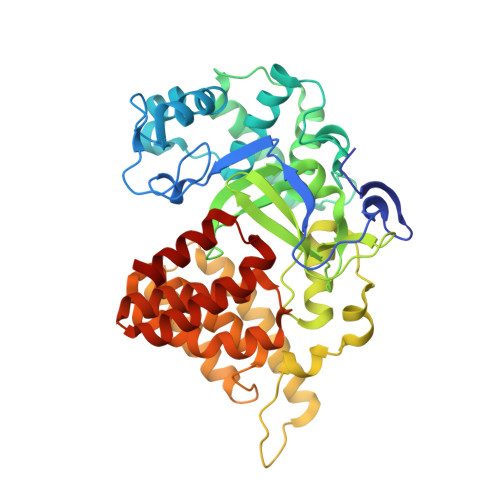Selective, Small-Molecule Co-Factor Binding Site Inhibition of a Su(var)3-9, Enhancer of Zeste, Trithorax Domain Containing Lysine Methyltransferase.
Taylor, A.P., Swewczyk, M., Kennedy, S., Trush, V.V., Wu, H., Zeng, H., Dong, A., Ferreira de Freitas, R., Tatlock, J., Kumpf, R.A., Wythes, M., Casimiro-Garcia, A., Denny, R.A., Parikh, M.D., Li, F., Barsyte-Lovejoy, D., Schapira, M., Vedadi, M., Brown, P.J., Arrowsmith, C.H., Owen, D.R.(2019) J Med Chem 62: 7669-7683
- PubMed: 31415173
- DOI: https://doi.org/10.1021/acs.jmedchem.9b00112
- Primary Citation of Related Structures:
6CBY - PubMed Abstract:
The first chemical probe to primarily occupy the co-factor binding site of a Su(var)3-9, enhancer of a zeste, trithorax (SET) domain containing protein lysine methyltransferase (PKMT) is reported. Protein methyltransferases require S -adenosylmethionine (SAM) as a co-factor (methyl donor) for enzymatic activity. However, SAM itself represents a poor medicinal chemistry starting point for a selective, cell-active inhibitor given its extreme physicochemical properties and its role in multiple cellular processes. A previously untested medicinal chemistry strategy of deliberate file enrichment around molecules bearing the hallmarks of SAM, but with improved lead-like properties from the outset, yielded viable hits against SET and MYND domain-containing protein 2 (SMYD2) that were shown to bind in the co-factor site. These leads were optimized to identify a highly biochemically potent, PKMT-selective, and cell-active chemical probe. While substrate-based inhibitors of PKMTs are known, this represents a novel, co-factor-derived strategy for the inhibition of SMYD2 which may also prove applicable to lysine methyltransferase family members previously thought of as intractable.
- Pfizer Medicine Design, Medicinal Chemistry , Pfizer Worldwide Research and Development , Eastern Point Road , Groton , Connecticut 06340 , United States.
Organizational Affiliation:


















